Another in a line of attempts to product “synth-like” sounds without the use of oscillators (and the pitch tracking that comes with them).
I love old string synths. They feel “cinematic” to me, like I am about to embark on an adventure in space. This patch attempts to capture some of that magic. It makes use of (a lot of) pitch-shifting, some filtering, a slow envelope, a drone note, and, of course, the all-important ensemble effect.
Your original note (and the drone note, made using a granular module) pass through an ADSR-controlled VCA, allowing for swells, before being split into pitches one octave up (pitchshifter), one octave down (granular), and a third, user-definable pitch (pitchshifter again). (You can define all of the pitches if you want, I just made this one convenient to change; moving away from the +/- octave settings loses the octave-divided, string machine sound.) These pass through a low-pass filter, onto the ensemble effect (a stereo bi-chorus, using two different rates).
When playing, the ADSR will only be triggered again if the envelope follower that controls it goes back to 0, at silence/muted. (I tried using an onset detector, and I tried using the envelope follower directly applied to the VCA, and none of them proved a perfect solution; this one was better than the others.) However, once the envelope is open, as you play, the sounds take on an “organ-like” quality, not dissmilar from the organs that were coupled with some of these older string synths.
This patch was, in part, inspired by Bill Ruppert’s Effectology video on replicating a string synth sound using EHX products; he uses an expression pedal to control the envelope, and I can recommend this method as a very satisfying alternative to the ADSR used here.
The dry signal is summed to mono (and heavily effected) before a stereo output through the stereo ensemble effect. The envelope-driven ADSR is derived from the left input.
A special thanks to my patrons on Patreon for their support: Rob Flax, Stepan Grammatik, and brockstar!
If you would like to support my work on ZOIA, please visit patreon.com/chmjacques
Controls:
Left stompswitch — ensemble on/off (keep it on! But the option is there)
Middle stompswitch — switches between envelope-driven ADSR and expression control over the VCA (a blue light will become bright to the right of the ADSR, indicating control has switched to expression)
This patch was, in part, inspired by Bill Ruppert’s Effectology video on replicating a string synth sound using EHX products; he uses an expression pedal to control the envelope, and I can recommend this method as a very satisfying alternative to the ADSR used here.
Front panel:
At the top are three controls for the sound:
LFO depth and rate — these control a triangle LFO (by default) assigned to the filter; its only really purpose is to add an additional sense of “movement” so its range is fairly constrained; I have starred the LFO, if you want to track it down and try a different shape
Ensemble depth — controls the depth of the bi-chorus ensemble effect; it doesn’t go all the way to “wacky pitch warbles” but it does become more pronounced (for better or worse) at the far end of the dial; I like it right about the middle
There are also several modules on the front page:
A pitch shifter lets you change the pitch of the third pitch shifting element — by default, this is set to +2 octaves, but a number of intervals can help produce a different “mood” in the patch
An ADSR — lets you shape the VCA envelope; by default, it’s set to a long attack/swell sort of sound
A mixer — lets you mix the voices together; channel 1 is +1 octave, channel 2 is -1 octave, channel 3 is the drone note+the dry signal, channel 4 is the user-defined pitch
Sound clip:
0:00-0:41 — Some chords, then some chords without ensemble (ew)
0:42-1:06 — Playing notes after the envelope has opened to give a sense of the ‘organ-like’ tone
1:07-1:32 — User-defined pitch tuned to -7 semitones to give a different ‘mood’ to the patch



I know I stress using the ‘ensemble’ effect in my patch notes, but if you want a fairly decent organ-ish tone (not really my thing), take off the ensemble effect, make sure the LFO depth is at 0 or very low with a fast rate, and change the envelope to a fast attack.